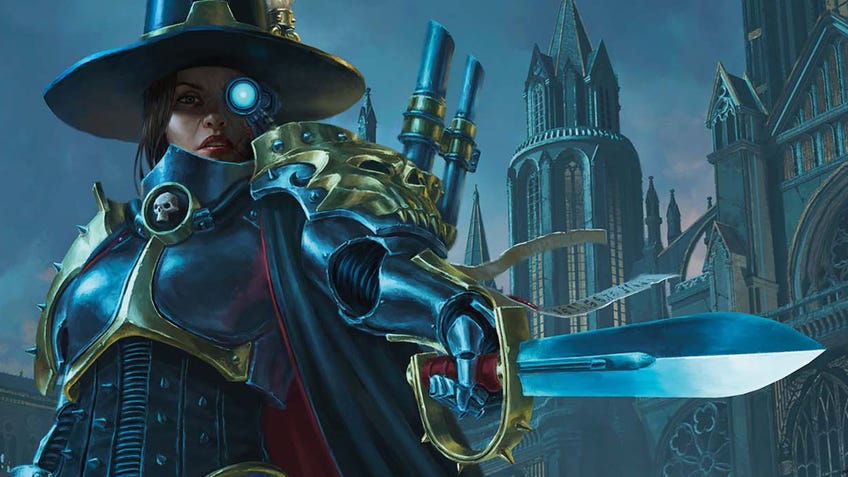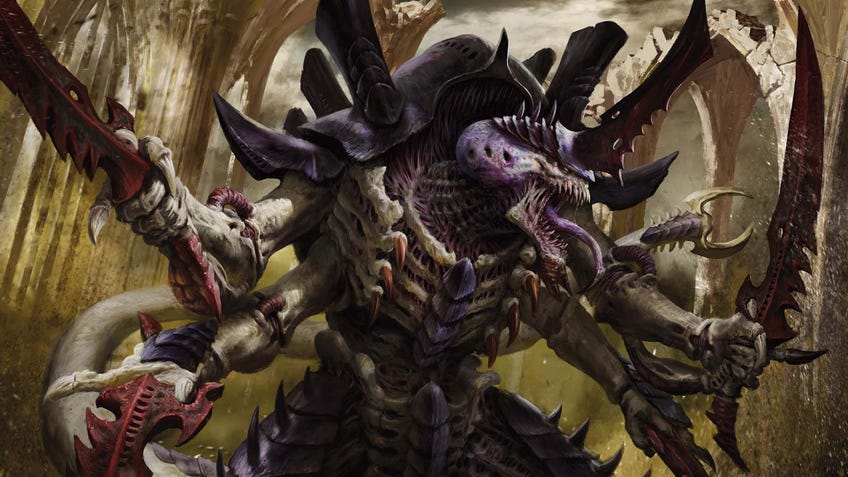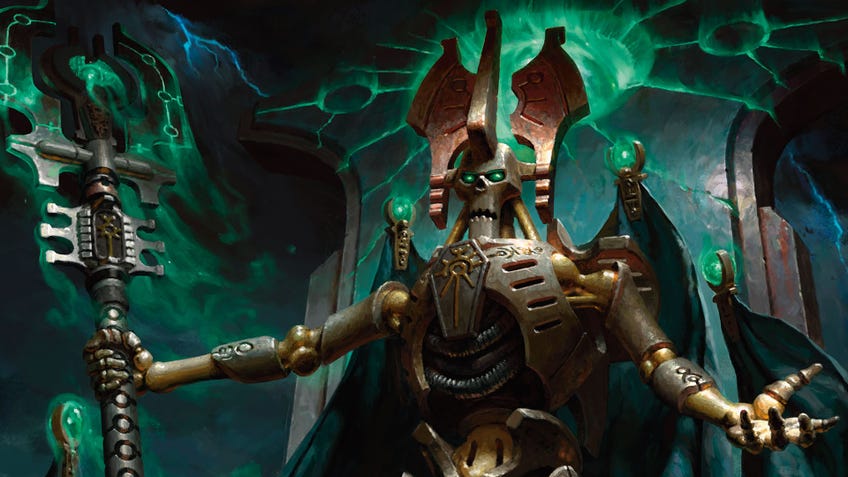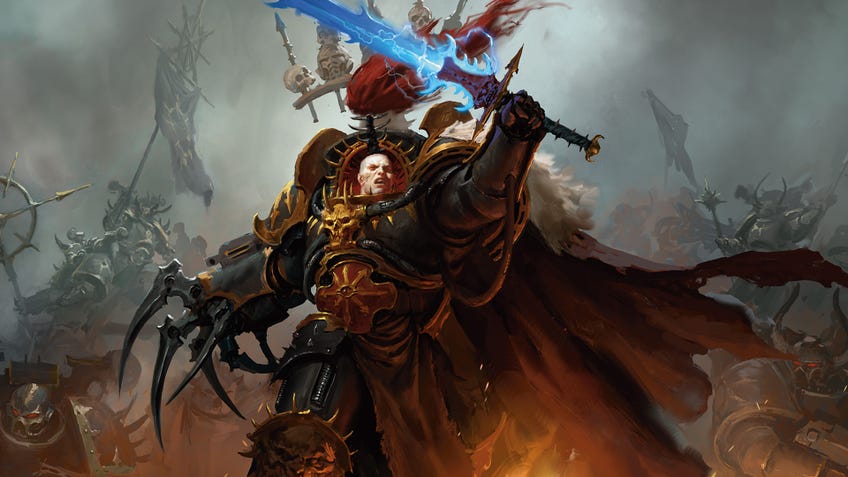Magic: The Gathering’s Warhammer 40,000 decks are a roaring success for fans of both games - if you can stomach the price
And the perfect place for newcomers to get into the TCG.
Magic: The Gathering’s Warhammer 40,000 Commander decks are upon us, and like a swarm of Tyranids they’re all over the place and ready to tear things apart. We mean that in a good way though, because this set is something of a shining example of how to do a crossover set in the Universes Beyond series.
That’s not what we’d call a bold claim given that MTG’s best crossover sets so far, the Dungeons & Dragons ones, aren’t even a part of the Universes Beyond line, and all of the things that are in the series tend to be Secret Lairs, which is a divisive product. It’s still nice to see that we can get cards that show a lot of love for both Magic: The Gathering and whatever it’s crossing over with, and MTG’s Warhammer 40k decks are the most sizeable and meaty set we’ve seen yet.
We’re going to get the big complaint out of the way early: the price. Each of the Warhammer 40k decks will set you back around £60, which means you’ll be shelling out £240 if you want all of them (assuming you can’t find a deal). That’s around double what you’d expect a Commander deck to cost at launch, and it gets worse. Because Wizards of the Coast absolutely refuses to not go all-in on capitalism, there are also collector’s editions of each of these decks, which will set you back between £100 and £200 - each.
Look, you’re allowed to make money, and you’re allowed to make special collector’s editions, but it’s becoming increasingly clear that someone, somewhere in Wizards’ chain of command that makes these decisions doesn’t want people to be able to enjoy Magic: The Gathering without having a worry-free wallet. It’s not like MTG has ever been a cheap hobby, not without a fair bit of effort. Still, the increasingly large price tags on many of the products feels gross, frankly.
Onto the decks themselves, where things are no less horrifying, yet in a far more enjoyable way. For starters, if you’re a Green player or a White player, this right here is a barren land that’s not for you. Apparently, the future is bleak and there’ll be no justice or nature there; it’s quite possibly the single coolest thing that Wizards has done with these decks, because it reflects the dystopia of Warhammer 40k brilliantly.
The four decks are Tyranid Swarm, The Ruinous Powers, Necron Dynasties and Forces of the Imperium. The Tyranids are basically a giant hive of insectoid monsters that roam around space eating things. The Ruinous Powers are beings that worship Chaos and revel in destruction. Necrons are undead androids who used to be living, but lost their souls when they transferred their minds into machines. Finally, the Imperium are about as close to the good guys as you can get in Warhammer 40k.

Each deck is focused on two main commander creatures and a different mix of mechanics and characters, but they still feel right when looking at general color identity, and all offer some fun new commanders to mess around with too.
The lack of Green and White is the single coolest thing that Wizards has done with these decks and reflects the dystopia of Warhammer 40k brilliantly.
Tyranid Swarm is a Green, Blue and Red deck where the main aim is to play creatures and give them +1/+1 counters. The Swarmlord is a viscous tyrant that sits atop the Tyranid ladder, and has destroyed countless worlds, and is also the first legendary creature and is a 5/5 that costs six mana. It enters with two +1/+1 counters for each time you’ve cast your commander from the command zone that game, and also lets you draw a card whenever a creature you control with a counter on it dies.
Tyranid wizard Magus Lucea Kane is the other choice and costs four mana as a 1/1. It lets you put a +1/+1 counter on a creature on each of your turns, and also taps for mana for X-cost spells before doubling those spells or abilities. The aim here is big creatures, big spells and big tokens. It’s about creating an army of creatures that get steadily stronger over time, which is always fun.

The Ruinous Powers deck is Blue, Black and Red, and wants you to sacrifice your opponents for additional strength and play demons. Abaddon the Despoiler is the master of the Black Legion of Chaos Space Marines and the most notorious traitor in 40k lore. He is a five-mana 5/5 with trample that gives spells in your hand cascade as long as your opponents have lost life that turn.
Be’lakor, the Dark Master is a six-mana 6/5 with flying that lets you draw cards when it enters equal to the number of demons you control, and then lets you deal damage to any target whenever you play a demon. These cards complement each other well; you can definitely choose to build Abaddon as a direct damage all-in instants and sorceries deck, and Be’lakkor, the Dark Master might just be the coolest tribal demon commander going.
Necron Dynasties is a mono-Black deck, meaning it’s slightly less versatile than the other options, but also means no mana issues. Szarekh, the Silent King is a four-mana 3/4 with flying that lets you mill cards when it attacks, then put an artifact creature or vehicle into your hand from those cards.
Imotekh the Stormlord is more interesting as a four-mana 3/3 that creates two 2/2 artifact creatures when an artifact leaves your graveyard, and also grants an artifact creature you control +2/+2 and menace for a turn. This is a surprisingly attack-heavy deck, and the focus on artifacts and vehicles an interesting one for a precon.
The differences between the decks act as a very good introduction to Magic: The Gathering for Warhammer players playing for the first time.
Finally, we have Forces of the Imperium, a White, Blue and Black deck that’s mostly about tokens. The first commander is Inquisitor Greyfax: a four-mana 3/3 with vigilance that gives you other creatures +1/+0 and vigilance, and also allows you to tap an opponent’s creature down and create a clue token.
Marneus Clagar is a five-mana 3/5 with double strike who lets you draw a card when a token enters the battlefield under your control, and also allows you to pay six mana to create two 2/2 tokens with vigilance. Marneus is possibly the most exciting new legendary creature in the Warhammer 40k set and feels incredibly powerful. The deck as a whole is great for players who value, well, value above all else.

The differences between the decks, despite many of them sharing colours, actually act as a very good introduction to Magic: The Gathering if Warhammer players are popping in for the first time. That said, there’s a lot of text on these cards - which is basically always the case now in MTG - and if you wanted to introduce someone to the game, having to bring a thesaurus to the session isn’t going to help anyone out.
There’s also the matter of these cards being legal in Legacy and beyond. There are some powerhouse cards in the set outside of the commanders themselves. Poxwalkers, a three-mana creature with deathtouch that comes back from the grave when you cast a spell that’s not in your hand, is definitely a candidate for Legacy, for example.
There’s also the issue of purity for some people, too. While we’re not that fussed, some believe Universes Beyond is corrupting the card game by taking it too far outside of MTG. Honestly, the Fortnite-ification of MTG is the least of our worries when you look at the burnout-inducing onslaught of previews and sets, and frankly disgusting pricing practices - like reprinting the Power Nine, but not in a tournament-legal way and in packs that will set you back a cool $1,000 to purchase. If your biggest worry is that Jace might be facing off against a Tyranid, then, to put it bluntly, we’re not sure you’re paying attention to what’s happening to MTG.

As ever, though, it’s important to view each product outside of the issues at large. With that in mind, MTG’s Warhammer 40,000 Commander decks are a roaring, bolt pistol-firing success. There are oodles of flavour packed into the new and returning cards, the artwork is good, the decks themselves are a joy to play and tinker with, and mechanically they can slot into Commander as a format with no fuss.
These decks are the new standard for Universes Beyond, and the first time we’ve really believed in them as an idea. Sure, Secret Lairs are good if you’re looking to recognise things like that Leo DiCaprio meme, but they’re not really adding to the game. Here we have four Magic: The Gathering decks that feel as mighty as a Space Marine should. Despite the price, that’s a very hard thing to not enjoy.










